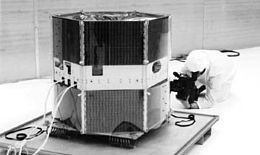Names Explorer 72, STEDI 1 Operator CU Boulder (LASP) SATCAT no. 25223 Inclination 97.97° Launch mass 120 kg | Mission type Atmospheric research COSPAR ID 1998-012A Launch date 26 February 1998 Period 1.6 hours | |
 | ||
Website lasp.colorado.edu/home/snoe/ Similar Solar Mesosph, Solrad 8, CHIPSat, Explorer 11, Explorer 8 | ||
The Student Nitric Oxide Explorer (SNOE), also known as Explorer 72 and STEDI 1, was a small scientific satellite which studied the concentration of nitric oxide in the thermosphere. It was launched in 1998 as part of NASA's Explorers program. The satellite was the first of three missions developed within the Student Explorer Demonstration Initiative (STEDI) funded by NASA. The satellite was developed by the University of Colorado Boulder's Laboratory for Atmospheric and Space Physics (LASP) and had met its goals by the time its mission ended with reentry on December 13, 2003.
Contents
Background
SNOE was the 72nd mission of the Explorer program by NASA dedicated to the scientific investigation of the space environment of the Earth. SNOE was the first of three projects developed within the university satellite program (STEDI) whose objective is to reach students in the development of satellites with limited means in the context of the strategy of "faster, better, cheaper" promoted by then-NASA administrator Daniel Goldin. The program was funded by NASA and managed by the Universities Space Research Association. The mission, developed by the University of Colorado Boulder in 1994, was selected among 66 proposals to be one of the six pre-selected satellites of the program. In February 1995 the satellite was selected along with TERRIERS of Boston University and CATSAT of the University of Leicester in the United Kingdom. SNOE was built and operated entirely by the Laboratory for Atmospheric and Space Physics of the university.
Objectives
The objective of the mission was the detailed study of variations in the concentration of nitrogen monoxide in the thermosphere. Nitric oxide, though a minor component of this region of space, has a significant impact on the composition of ions in the ionosphere and in the heat of the thermosphere. The detailed objectives are:
Specifications
SNOE had a compact hexagonal structure 0.99 m (3.23 ft) high and 0.94 m (3.08 ft) wide with a mass of 115 kg (254 lb). It was spin-stabilized at five revolutions per minute, and its axis of rotation was perpendicular to the orbital plane. The exterior of the satellite was covered with solar cells that provide 37 watts.
Scientific instrumentation
SNOE was equipped with three scientific instruments:
The satellite features a GPS receiver to accurately determine its orbit and orientation.
Conduct of the mission
SNOE was launched on 26 February 1998 at 07:07 UTC by a Pegasus-XL rocket. The rocket was lofted by Orbital Sciences' Stargazer L-1011 aircraft based out of Vandenberg Air Force Base. SNOE was placed into a Sun-synchronous orbit of 535 by 580 km (332 by 360 mi) with an inclination of 97.7 degrees. The spacecraft functioned normally until its orbit degraded and it reentered the atmosphere on 13 December 2003.
